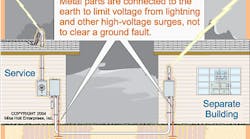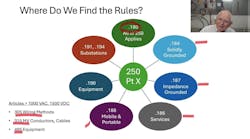All Code references are based on the 2005 National Electrical Code. The grounding and bonding requirements in this column apply to solidly grounded systems that operate at not more than 600V, such as 120/240V, 120/208V, and 277/480V.
Art. 250's requirements for grounding and bonding, which begin in 250.4, can be broken down into two groups:
- Grounded systems [250.4(A)]
- Ungrounded systems [250.4(B)]
It may seem odd that the NEC has grounding and bonding requirements for ungrounded systems, but 250.4's first requirement is for grounding in grounded systems, so that's where we'll start.
Grounding and bonding in grounded systems. The NEC requires you to ground (earth) system windings to limit the voltage imposed on the system by lightning, unintentional contact with higher-voltage lines, or line surges (Sidebar below). Another function of this earthing is to “stabilize the voltage to earth during normal operation” by providing a common reference point.
The NEC also requires you to ground (earth) metal parts of electrical equipment in or on a building or structure. See 250.24(A) for services and 250.32(A) for separate buildings or structures. You accomplish this grounding (earthing) by using a grounding (earthing) electrode conductor [250.64(A)] to electrically connect the building or structure disconnecting means (225.31 or 230.70) to a grounding (earthing) electrode [250.52, 250.24(A), and 250.32(A)] (Fig. 1 above).
However, grounding (earthing) has its limitations. Grounding (earthing) of electrical equipment doesn't provide a low-impedance fault-current path to clear ground faults. In fact, the Code prohibits the use of the earth as the sole return path because it's a poor conductor of current at voltage levels below 600V [250.4(A)(5) and 250.45(B)(4)].
In addition, grounding (earthing) the metal parts of electrical equipment doesn't protect electrical or electronic equipment from lightning-induced voltage transients (high-frequency voltage impulses) on the circuit conductors inside the building or structure. Nor does it protect equipment within a structure from transients generated from other equipment in that structure.
To provide protection from voltage surges, you must engineer a proper surge protection system. The design should address surge protection devices (Art. 280 and 285) at service equipment, panelboards, and critical loads. Although it isn't covered by the NEC, you could also consider point-of-use surge protection in branch circuits.
Bonding in grounded systems has its own challenges. An “effective ground-fault current path” is a permanent, low-impedance path for fault-current, and it facilitates the operation of the circuit overcurrent protection device (OCPD) (250.2) (Fig. 2). Because the earth is a poor conductor, it doesn’t permit sufficient fault current to flow back to the system winding to open the OCPD. Thus, a rod or concrete-encased electrode won’t assist in clearing a ground fault [IEEE 142 Section 2.2.8] (Fig. 3).
A ground fault clears on a circuit through the automatic opening of the OCPD. The time it takes for an OCPD to open is inversely proportional to the magnitude of the fault current. Thus, the higher the ground-fault current value, the sooner the OCPD will open and clear the fault.
To quickly remove lethal touch voltage from metal parts after a ground fault, the fault-current path must have sufficiently low impedance for the fault current to quickly raise and facilitate opening the OCPD. For example, a 20A circuit with an overload of 40A (two times the rating) would trip a breaker in 25 to 150 seconds. At 100A (five times the rating) the breaker would trip in 5 to 20 seconds.
Thus, the effective ground-fault current path is critical. And you establish it through bonding. Start by connecting non-current carrying conductive materials of electrical equipment together and to the electrical supply source [250.4(A)(3)].
Do the same for electrical raceways, cables, enclosures, equipment, and other electrically conductive materials “likely to become energized” [250.4(A)(4)]. Whether something is “likely to become energized” is subject to interpretation by the authority having jurisdiction (AHJ).
Dangerous voltages can also exist on metal water, sprinkler, and gas piping, and exposed structural steel members, so if any such items are likely to become energized, you must bond them to the effective ground-fault current path.
Grounding and bonding in ungrounded systems. When used to describe a system, the term “ungrounded” refers to its supply configuration and wiring scheme. In a grounded system, the supply transformer secondary windings may be wye-configured with the center tap grounded or it may be delta-configured with a corner grounded.
Unlike a grounded system, an ungrounded system doesn't have a winding grounded at the supply transformer. This allows for continued operation if you have a ground fault on one phase. Presumably, qualified personnel will locate and repair the fault before a ground fault on a second phase takes the system down.
Ungrounded systems are common in factories in the southern United States. These facilities typically have ground-fault monitors to alert maintenance personnel to a ground fault on any phase. For example, the Daramic plant in Owensboro, Ky., has a ground-fault monitor on the wall between the maintenance offices and the machine shop — where maintenance personnel pass by frequently.
But maintenance crews at such facilities must repair the fault promptly. If a ground fault persists on an ungrounded system, the system could experience overvoltage-to-ground as high as eight times the phase voltage. This excessive voltage can puncture conductor insulation and create additional ground faults.
Whether your system is grounded or ungrounded, you must bond enclosures and equipment together. In ungrounded systems, bonding of electrical equipment [250.4(B)(2)] serves a purpose similar to that set forth for bonding electrical equipment in grounded systems [250.4(A)(3)]. The difference here is you're bonding the ungrounded system equipment to each other, rather than to each other and the source.
One consequence of this arrangement is the equipment-bonding path must be capable of carrying the maximum fault current likely to be imposed on it. Remember, the bonding system must be able to remove dangerous voltage from a second ground fault.
The same difference and consequence applies to the bonding of electrically conductive materials and other equipment in ungrounded systems [250.4(B)(3)] vs. those in grounded systems [250.4(A)(4)].
Fault current paths. Requirements for establishing fault current are similar for grounded and ungrounded systems. In neither case can you use the earth as the sole equipment-grounding conductor or consider it a fault current path.
And in both cases you must install electrical equipment, wiring, and other electrically conductive material likely to become energized in a manner that creates a permanent, low-impedance circuit. Yet this requirement has one key difference:
-
For grounded systems, you must establish an effective ground-fault current path. The circuit must be able to safely carry the maximum ground-fault current likely to be imposed on it from any point in the wiring system where a ground-fault to the supply source may occur.
-
For ungrounded systems, you must establish a fault current path (not ground-fault current path). The circuit facilitates the operation of overcurrent devices if a second ground fault occurs.
A single ground fault can't be cleared on an ungrounded system because there's no low-impedance fault-current path to the source. However, all metal parts of an ungrounded system must be bonded together so the bonding path will provide a low-impedance fault-current path in the event of a second ground fault (line-to-line fault). This will allow the OCPD to clear the fault [250.4(B)(4)].
You'll notice more of the differentiation between grounding and bonding as you continue studying grounding and bonding in Art. 250.
Sidebar: Lightning and Surges
When lightning occurs, high voltages drive high current (as much as 40,000A) into the earth for a fraction of a second. Typically, lightning strikes to wiring occur outside. Therefore, grounding (earthing) the system windings will assist the flow of lightning into the earth.
When a ground fault over 600V occurs, voltage on the other phases can rise significantly during the fault (typically three to 12 cycles). This voltage surge during the utility ground fault will be transformed into an elevated surge voltage on the secondary, possibly destroying electrical and electronic equipment. The lower the resistance of the utility grounding (earthing) system, the lower the secondary voltage surge.




